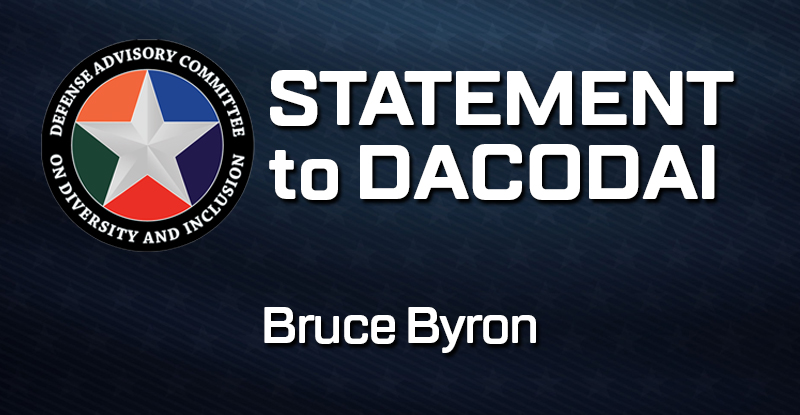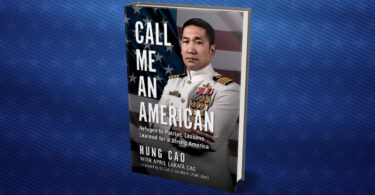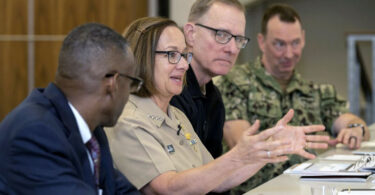Statement to DACODAI by former US Navy Lt. Bruce Byron
Subject: DEI in the military
After fifty years in public agencies and private companies, I am familiar with people, organizations, and the military. As a Naval Officer, I served four years sea duty—two Vietnam combat tours as a destroyer division officer and two years as a ship’s executive officer.
Afterwards, I spent forty years in management in public and private organizations. This includes teaching leadership at the Texas Department of Transportation and being a City Administrator for four years. All my experience leads me to believe that people respond best to being treated as individuals and judged based on their own merits.
I was on active duty when tensions surfaced between blacks and whites. Racial diversity may have precipitated the conflict, but it was not the solution. The solution was the ability to integrate individuals of diverse backgrounds into a “crew.” When we approached problems between races on an “us vs them” basis, the problems got worse. When we approached the problem on an individual basis, tensions relaxed, and crew members reconciled.
Just as the country’s motto of “e pluribus unum”-“out of many, one”, was a guide to building a nation, so building a “crew” or working organization depends on achieving likeness – common goals – common mission.
DEI is based on deeply flawed assumptions. There is no inherent advantage to diversity. It is easier to build an effective group of people with common backgrounds. Building an effective team out of diverse backgrounds may be necessary but requires more effort. You forge a crew on commonalities, especially goals and values, not focusing on differences or catering to subgroups.
Equality of treatment was expected. We were literally all in the same boat. But equity of outcome is forced equality.
Every time I counseled a sailor, I asked about their personal goals. They were all different and distinct regardless of race, ethnicity, or economic background. I then discussed how they could dovetail their goals and their service to the Navy. Even if the conclusion was that the Navy was what they did not want to do in the future, there was an agreement on how to best meet both goals. Their outcome was then dependent on their actions and talents.
I swore when I became an executive officer, I would determine the top ten performers of a crew of eighty and do everything I could do to reward them with schools and promotions.
Also, I swore I would determine who were the bottom ten and do everything I could to “square” them away or discharge them. (Keep in mind this was 1973-74 during the end of the Vietnam war and the transition from a draft induced Navy to “all-volunteer” when few wanted to volunteer. I was also on a service force ship that got the bottom end of recruits and the undesirable transfers from other ships.)
In two years, I discharged thirteen people from the Navy for reasons from incompatibility to drugs to UCMJ (Uniform Code of Military Justice) violations.
What had not occurred to me initially was the impact on the group in the middle who quickly realized that superior performance was rewarded and slackers and rule breakers were removed. The resulting teamwork improved the ship’s performance and morale. “Out of many, one”.
And what can I say about inclusion? Inclusion for its own sake does nothing toward unit effectiveness. In fifty years in various public and private organizations both large and small, I have never seen an organization prosper by selecting people based on arbitrary characteristics such as race or gender but by seeking and keeping the highest performing individuals who fit the organization. Especially, with our all- volunteer military, like any successful sports team, you recruit the best talent.
Lastly, a characteristic that cuts across all DEI distinctions and has relevance that may override merit is gender. We must admit what we all intuitively know that men and women are different. They are biologically different and, in ways, socially different. Trying to merge the two sexes has made men weaker and women coarser.
If I were to be a ship’s captain today, give me a crew of all men or all women but do not expect a mixed gender crew of young adults at sea for six months not to have problems. Each gender brings different strengths to the organization. Use them appropriately. And do not get me started on the insanity of including people in the military who have gender confusion. The negative impacts on unit cohesion far outweigh any individual skill they may bring.
The military should not be used to enact any administration’s social goals. Its mission is to defend this country. No race, gender, ethnicity, or group has a “right” to be in the military. The needs of the service should come first. Those needs are based on being an effective fighting organization built on unit cohesion or “teamwork.”
The military used to be a shining example of how to make America’s melting pot work towards a noble end. Today’s emphasis on social engineering has led to a decline in both the quantity and quality of recruitment.
Going forward, we must return to a colorblind meritocracy that treats people as individuals and places each gender in their appropriate role, not based on their desires or political correctness, but the needs of the service.
Respectfully and sincerely.
Bruce B Byron
Former Lt. USN








Leave a Comment